Memory Scaling on Core i7 - Is DDR3-1066 Really the Best Choice?
by Gary Key on June 24, 2009 9:00 AM EST- Posted in
- Memory
Even though our DDR3-2000 kits were not cooperating with us, we were able to run a few benchmarks to determine which memory setting would be ideal at our 3.8GHz (19x200) processor speed. We arrived at this clock speed, as it is a free overclock with only VTT needing to be increased to handle our particular memory speeds and timings. We will take a look at other overclocked speeds and memory settings in the near future.
Everest 5.02.1765
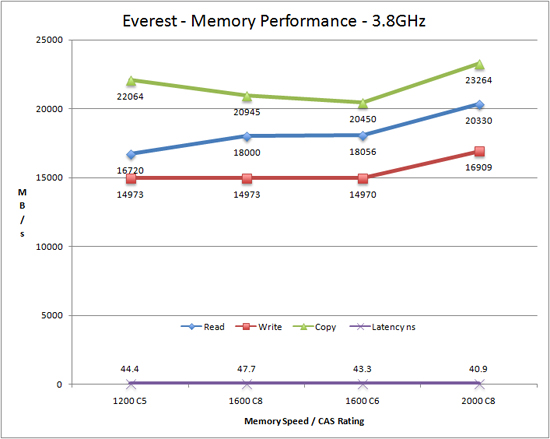
Going from 1250 C5 to 2000 C8 nets a 5% improvement in memory reads, 21% in writes, 13% in copy speeds, and 8% in latency. Interestingly enough, 1200 C5 provides excellent results compared to 1600 C8 and our application benchmarks reflect this fact.
AutoCAD 2009 x64
We utilize AutoCAD 2009 x64 and the Cadalyst Labs benchmark.

Just like our stock clock results, the 3D scores are respond better to the slower memory speeds. Once again, decreased latencies and greater bandwidth generally resulted in improved 2D and CPU scores.
3ds Max 2009 x64
We utilize a rather large mental ray image and track the time it takes to render it.
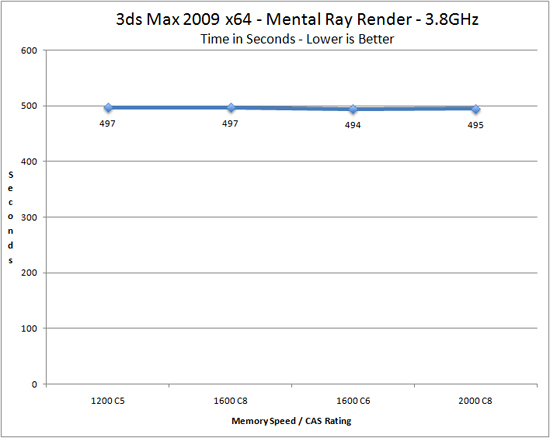
In our stock test we measured a 3% increase in performance (19 second reduction) moving from DDR3-1066 C7 to DDR3-1600 C6. In our overclock test the 2 second difference between 1200 C5 and 2000 C7 is minimal as clock speed is king at this point.
LightWave 3D 9.6 x64
We time the rendering of a single frame from an office building animation. The time to render the full scene is approximately four and a half hours.
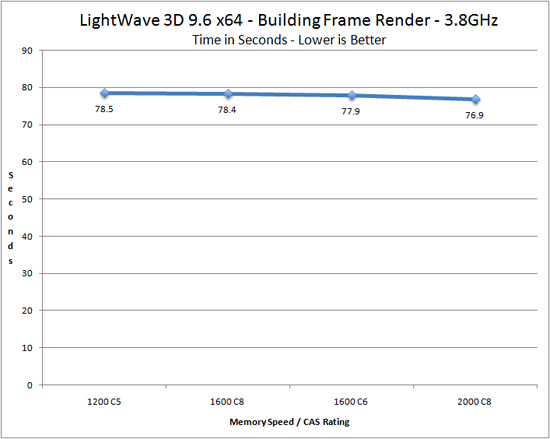
The stock test revealed a 6% advantage for DDR3-1866 C7 over DDR3-1066 C7. The overclock test indicates a 2% advantage for 2000 C8 compared to 1200 C5.
WinRAR 3.9b3 x64
This benchmark compresses our AT workload consisting of a main folder that contains 954MB of files in 15 subfolders. The result is a compressed file approximately 829MB in size.
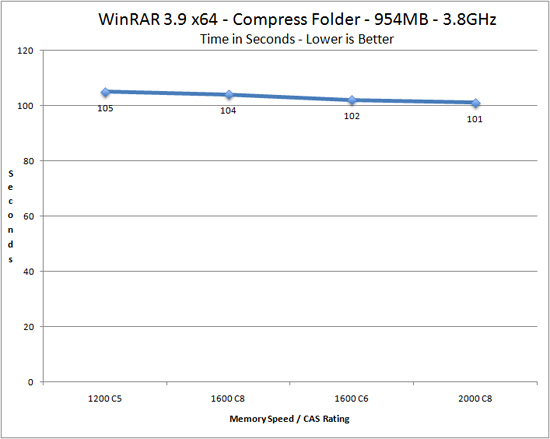
In our stock tests, going from DDR3-1066 C7 to DDR3-1866 C7 resulted in a 20% decrease in processing time. With our processor overclocked to 3.8GHz, this benchmark provides a 4% increase in performance when moving from 1200 C5 to 2000 C8.
MainConcept Reference 1.61
We set our profile to iPOD HQ NTSC and then transcode a 651MB 1080P file to a iPOD friendly 34.7MB file.
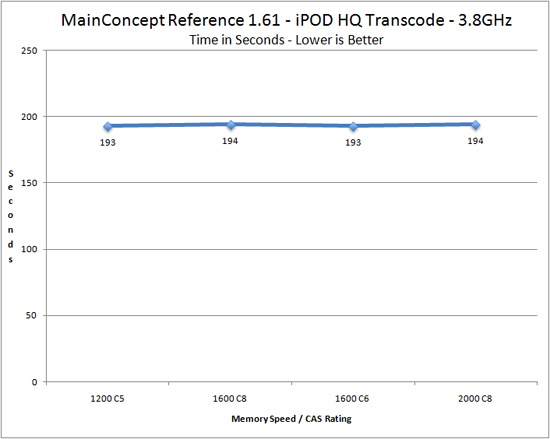
Our stock test showed a 3% improvement in performance when scaling from DDR3-1066 to DDR3-1866. Overclocking our system resulted in a .05% variation in the score with our two low latency settings performing ever so slightly better.










47 Comments
View All Comments
Seikent - Wednesday, June 24, 2009 - link
I'm not very sure if it's relevant, but I missed a load times comparation. I know that the bottleneck there should be the hdd, but I still think that there can be a performance boost.deputc26 - Wednesday, June 24, 2009 - link
ave and min lines are mixed up.MadBoris - Wednesday, June 24, 2009 - link
I'll be considering upgrading in October at the same time I go from XP to Win 7.So this is good to know if/when I go Core I7.
I guess I can see how Winrar RAM workload sdtays high since it grabs the buffers of compressed data chunks and writes them to disk as fast as the HW permits, so bandwidth matters then.
While it looks like very few apps can saturate the bandwidth latency benefits/penalties are always having an effect as usual.
Maybe I missed it but I didn't see anywhere in the article that tried to explain the technical reasons "why" 2000 doesn't provide advantage over 1066.
I understand the differences of latency and bandwidth. Is it really because no software is using RAM workloads large enough to benefit from increased bandwidth (except compression) or is there another bottleneck in the subsystem or CPU that doesn't allow moving all the data the RAM is capable of?
vol7ron - Wednesday, June 24, 2009 - link
Your question is long, so i didn't read it all, but does bottom of pg2 answer:"That brings us to another story. We had planned to incorporate a full overclocking section in this article but our DDR3-1866 and DDR3-2000 kits based on the Elpida DJ1108BASE, err Hyper ICs, have been experiencing technical difficulties as of late."
They said some other stuff, but it seems like it wouldn't be right to post info on faulty chips.
TA152H - Wednesday, June 24, 2009 - link
I'd like to see a test between the crippled i5 memory controller with very fast memory, and the i7 with low cost 1333 Mhz memory. There's really no point in the 1066 memory, except for Dell, HP, etc... to throw in generic machines; it's not much cheaper than 1333 MHz, and the performance bump really seems to be biggest there. I think 1333 MHz (low latency) is a reasonable starting point for most people, the cost seems to warrant the performance. After that, you definitely see diminishing returns.It seems anyone buying an i5 with very expensive memory is probably a fool, but, a few benchmarks might be interesting to validate or invalidate that. Of course, the i5 might be better when released, so even then it wouldn't be proof.
Gary Key - Wednesday, June 24, 2009 - link
I wish I could show i5 numbers, but that ability is officially locked down now. I can say that our results today will not be that much different when i5 launches, low latency 1333 or possibly 1600 will satisfy just about everyone. :)strikeback03 - Thursday, June 25, 2009 - link
Of course, by the time you can share those numbers we will most likely have to specify whether we are talking about LGA-1366 i7 or LGA-1156 i7. Thanks Intel.kaoken - Wednesday, June 24, 2009 - link
I think there is a mistake with the farcry graph. The min and avg lines should be switched.hob196 - Thursday, June 25, 2009 - link
Looking closer it might be that you have the SLI min on there instead of the Non SLI min.halcyon - Wednesday, June 24, 2009 - link
It's so nice to see AT calling things as they are.This is why we come here.
Straight up honest talk from adults to adults, with very little marketing speech and numbers do most of the talking.
Excellent test round up, mucho kudos.